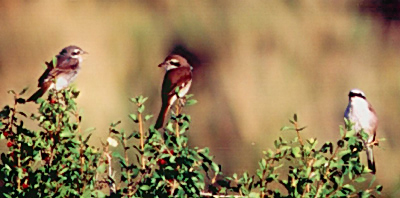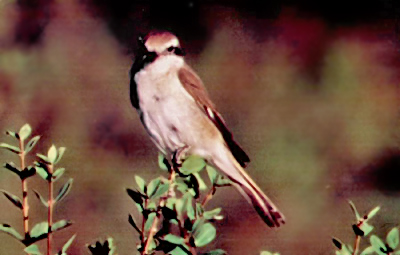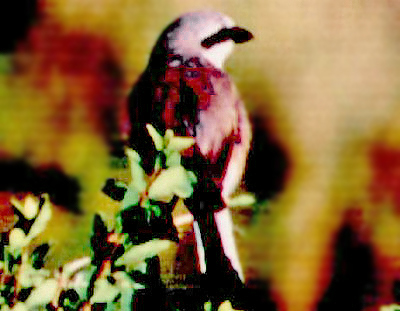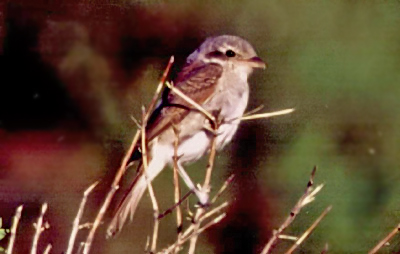In a Swedish article in Roadrunner in 2003, Lars Svensson wrote: "The skin collection in Almaty shows that there is a continuous gradation from karelini to isabellinus, thus not supporting splitting of phoenicuroides and isabellinus into separate species. It’s not only that 75% of the females and even more juveniles are indistinguishable, but also that many males show a frustrating mix of characters."
In the same article, he also wrote of hybridization between Isabelline and Red-backed Shrike, and Isabelline and Brown Shrike where they meet in Central Asia. Although some of the variability of hybrid offspring had already been suggested by the plates in Worfolk (2000), a series of images sent to us by Jochen Roeder of some hybrids in Kazakhstan (presumed Red-backed x Isabelline) seems to undermine confidence further that each and every extralimital shrike can be identified - to any kind of level of exactitude. Although there are quite a few individuals that appear "pure" and can be confidently assigned, surely more than a few cannot.
Jochen takes up the story:
"These shrikes were encountered in mountain areas immediately to the south-east of Lake Saisan in far eastern Kazakhstan, close to the border with China. The shrikes around Almaty all appeared be "typical" phoenicuroides Isabelline, and on two visits to Kirgizstan I also found only "typical" phoenicuroides. The fun starts, however, around Saisan!
These photographs are not pictures of specific shrikes there that I found to be especially interesting. No, I simply photographed all the shrikes I could get close to, so the images are not of extraordinary birds but of "average" ones. And that makes the whole story even more interesting…
How to identify the females in these photos?
Both are paired with a rather typical (though largely grey-backed!) Red-backed Shrike. Female 1 has a rather typical juvenile Red-backed offspring. Is Female 1 a rather typical female Isabelline phoenicuroides?
Female 2 looks somewhat closer to a typical female Isabelline of the subspecies arenarius (based on its paler coloration, and lack of a white primary patch)… But then, what an amazing coincidence that both females are actually paired up with "typical" Red-backed Shrikes! Indeed, most of the male shrikes in that area showed the black-and-white tail pattern, but NONE of the females looked like Red-backed females are supposed to look like. So, if so many females of phoenicuroides or arenarius or whatever form are hybridising with Red-backed Shrikes -
Why aren’t male Isabellines?
Where are the male Isabellines in this zone of overlap?
Where are the typical female Red-backedShrikes in an area where there are almost exclusively typical Red-backed males and hardly any males of any other form?
Why were there only mixed pairs of male typical Red-backed with females of whatever form of Isabelline they were, and not vice versa?
And what a strange coincidence that two females resembling different Isabelline subspecies should breed within the area of overlap with Red-backed in such close proximity to each other!
And now you state that Female 2 would most likely be identified as a Brown Shrike in Korea !! (NM had written to JR: "I can understand why both the females might be (largely) phoenicuroides ...but especially female two would surely very likely be overlooked as a bright-tailed Brown here in Korea, despite its pinkish bill-base).
So I must be a really lucky birder to find hybrid pairs containing Brown and Isabelline Shrikes in close proximity to each other, and both of these paired with Red-backed!
Listing all these really strange "coincidences" it seems safest to assume that both females are actually hybrids themselves with Red-backed Shrike, and have at least a significant amount of Red-backed genes in them (if the females are statistically of the same genetic composition as the males, then the vast majority of their genes should be Red-backed because the males look rather typical). This is further emphasized by the very Red-backed-like offspring of Female 1 (although the female itself doesn’t look anything like a female Red-backed!).
These photos demonstrate quite graphically that the problem of identification of extralimital, and even within range (!), shrikes is not only limited to Isabelline Shrike versus Brown Shrike - you even have to take female Red-backed into account when confronted with an "atypical" shrike!
Now, looking at your article on Brown Shrike, what about the female in picture number 23? It looks just like a ’typical eastern Kazakhstan Red-backed’ ("female 2" type). A first for Korea?..Ok, sure - I am just kidding!
But it really is astonishing how certain some people are in their identification of extralimital "brown-redbacked-isabelline" shrikes…
Can you imagine if some (un)lucky birder found a bird like "female 1" somewhere in Europe? And the rarities committee rejected the record - because female Red-backed Shrike couldn’t be completely ruled out?
Well, to cut the now already long story short: THAT would be SHOCKING!"





Return to Brown Shrike Lanius cristatus - appearance and variability of individuals seen on migration in South Korea.




